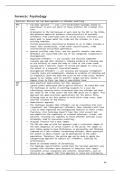Summary
Samenvatting ECG-leer & ritmestoornissen
- Course
- Institution
Samenvatting (van 19 A4) van alle behandelde kennis met betrekking tot ECG's tijdens de opleiding tot anesthesie medewerker aan de amstel academie; namelijk: AZT: ECG kennis AZT: ECG ritmes uit sinus AZT: ECG ritmes uit atria AZT: ECG ritmes uit de AV-knoop AZT: ECG AV-geleidingsstoornissen ...
[Show more]












